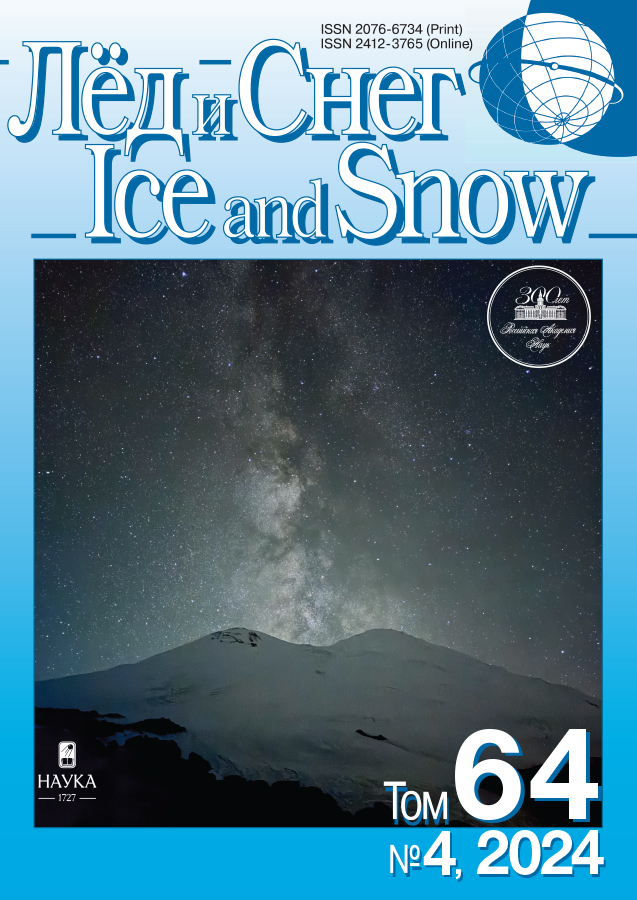Features of the periglacial drainage lakes in Svalbard
- Autores: Romashova K.V.1, Chernov R.A.2
-
Afiliações:
- State Scientific Center “Arctic and Antarctic Research Institute”
- Institute of Geography, Russian Academy of Sciences
- Edição: Volume 64, Nº 4 (2024)
- Páginas: 543-549
- Seção: Glaciers and ice sheets
- URL: https://journals.eco-vector.com/2076-6734/article/view/684216
- DOI: https://doi.org/10.31857/S2076673424040057
- EDN: https://elibrary.ru/HTMXFE
- ID: 684216
Citar
Texto integral
Resumo
There are 705 periglacial lakes in Svalbard, formed by glacial retreat after the Little Ice Age. 98 of these lakes, with an area of more than 100 000 m2, have river outflow. The rivers flowing from these lakes have significant channel slopes characteristic of mountainous regions. Most rivers flow into fjords. The morphometry of these objects has a characteristic feature: lakes have significant water surface areas, on average about 1.5 km2, and rivers have a small length, on average about 2.5 km. To the greatest extent, these parameters correspond to moraine-dammed lakes located in the west of Svalbard. On the example of the moraine-dammed Lake Bretjørna with an area of 1.6 km², it is shown that that the seasonal runoff from it is 2.5—3 times greater than the volume of the lake. Seven lakes have been identified that are of interest for studying sedimentation changes since the Little Ice Age, both in lake basins and in marine estuaries.
Palavras-chave
Texto integral
Sobre autores
K. Romashova
State Scientific Center “Arctic and Antarctic Research Institute”
Autor responsável pela correspondência
Email: romashova.kv@hotmail.com
Rússia, Saint Petersburg
R. Chernov
Institute of Geography, Russian Academy of Sciences
Email: romashova.kv@hotmail.com
Rússia, Moscow
Bibliografia
- Aibulatov D.N., Shkolniy D.I., Sandjiev M.Y. Features of river mouths typing of the Svalbard Archipelago. Osobennosti tipizacii ust’ev vodotokov arhipelaga Shpicbergen. Sbornik dokladov mezhdunarodnoj nauchnoj konferencii pamyati vydayushchegosya russkogo uchenogo Yuriya Borisovicha Vinogradova “Chetvertye Vinogradovskie chteniya. Gidrologiya: ot poznaniya k mirovozzreniyu”. Saint Petersburg: Izd-vo VVM. 2020: 1032–1036 [In Russian].
- Meshcheriakov N.I., Kokin O.V., Usyagina I.S., Kasatkina N.E. The Periglacial Lake Bretjorna (Ledovoe), Western Svalbard: History of Formation and Recent Sedimentation. Led i Sneg. Ice and Snow. 2023, 63 (3): 426–440. https://doi.org/10.31857/S2076673423030067 [In Russian].
- Romashova K.V., Chernov R.A. Formation of new periglacial lakes in the Grønfjord basin (Svalbard) in 1938–2010. Led i Sneg. Ice and Snow. 2022, 62 (2), 193–202. https://doi.org/10.31857/S2076673422020125 [In Russian].
- Romashova K.V., Chernov R.A. Inventory methodology of periglacial lakes in Spitzbergen (Svalbard). Problemy Arktiki i Antarktiki. Arctic and Antarctic Research. 2023, 69 (2): 157–170. https://doi.org/10.30758/0555-2648-2023-69-2-157-170 [In Russian].
- Chernov R.A., Muraviev A.Y. Contemporary changes in the area of glaciers in the western part of the Nordenskjold Land (Svalbard). Led i Sneg. Ice and Snow. 2018, 58 (4): 462–472. https://doi.org/10.15356/2076-6734-2018-4-462-472 [In Russian].
- Chernov R.A., Romashova K.V. Large Periglacial Lakes on the Spitsbergen (Svalbard): State in 2008–2012 and Dynamics in 1991–2022. Led i Sneg. Ice and Snow. 2023, 63 (4): 525–539. https://doi.org/10.31857/S207667342304004X [In Russian].
- Usyagina I.S.,, Namyatov A.A., Meshcheriakov N.I., Boyko V.V. Heavy metals in the bottom sediments of the Gren fjord (West Spitsbergen) // Relief and Quaternary deposits of the Arctic, Subarctic and North-West Russia. 2023, 10: 276–282 https://doi.org/10.24412/2687-1092 [In Russian].
- Hanssen-Bauer I., Førland E.J., Hisdal H., Mayer S., Sandø A.B., Sorteberg A. Climate in Svalbard 2100 – A knowledge base for climate adaptation. NCCS report. 2019, 1: 207 p. https://doi.org/10.13140/RG.2.2.10183.75687
- Kavan J., Wieczorek I., Tallentire G.D., Demidionov M., Uher J., Strzelecki M.C. Estimating suspended sediment fluxes from thelargest glacial lake in Svalbard to fjord system using Sentinel-2 data: Trebrevatnet case study. Water. 2022, 14 (12): 1840. https://doi.org/10.3390/w14121840
- Pfeffer W.T., Arendt A.A, Bliss A., Bolch T. The Randolph Glacier Inventory: A globally complete inventory of glaciers. Journ. of Glaciology. 2014, 60 (221): 537–552. https://doi.org/10.3189/2014JoG13J176
- Wołoszyn A., Owczarek Z., Wieczorek I., Kasprzak M., Strzelecki M.C. Glacial Outburst Floods Responsible for Major Environmental Shift in Arctic Coastal Catchment, Rekvedbukta, Albert I Land, Svalbard. Remote Sens. 2022, 14 (24): 6325. https://doi.org/10.3390/rs14246325
- Norwegian Polar Institute’s topographical Svalbard map service. Retrieved from: https://toposvalbard.npolar.no/ (Last access: January 9, 2023)
Arquivos suplementares












